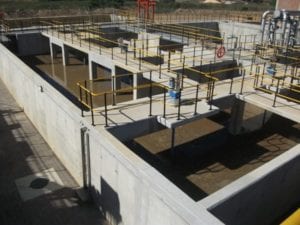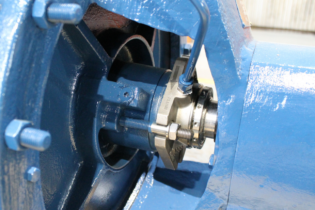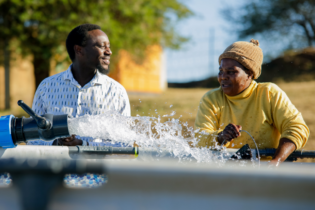Pictured: The MBR plant applies the well-established activated sludge process to treat wastewater (bioreactor filled with sludge)
The perception that wastewater treatment is the “less attractive” cousin to the delivery of potable water is slowly starting to change as the sector increases the level of experience and expertise available, believes Mpho Ramphao, water and wastewater engineer at engineering, management and specialist technical services group Aurecon. “The provision of potable water has long been one of the most attractive areas called upon in terms of supporting government in the roll-out of basic services, yet wastewater treatment is very much a forgotten service. The process of removing dirty water and toilet waste from homes and other centres simply does not have the same appeal for many, and it is regarded as a mundane profession by the ill-informed,” Ramphao tells Chantelle Mattheus. This is despite the fact that investing in this area has the potential to have just as much impact on disease control and improving living standards, while the infrastructure required is very similar. However, Ramphao believes that the wastewater sector is slowly gaining momentum. “I think this is largely attributable to the Department of Water Affair’s public education initiative on the Blue/ Green Drop process.” As CESA Young Engineer of the Year in 2011, Ramphao is one of the young, up-and-coming, innovative engineers working towards changing the dynamic in the South African context through Aurecon – the company he works for – and also by consciously working towards gaining experience through the access availed to him as part of the Aurecon team on large-scale cutting-edge wastewater projects. He believes, however, that there still remains a lot of work to be done to achieve the millennium development goals (MDGs), as there is still a huge backlog of wastewater infrastructure that needs to be constructed in South Africa, “especially in rural areas where there is virtually none, or in the case of urban areas, there is a lot that needs to be maintained, refurbished and or upgraded to meet the future demands of a large number of people moving into urban areas”. Leading innovationNot only is South Africa known and respected for its extensive network of large-scale schemes for the transfer of water and wastewater, but the country’s engineering skills are also well sought after internationally, notes Ramphao. “The country has seen many water and wastewater professionals leaving our shores to take up offers in other countries – to our detriment. This is attributed largely to the many wastewater technological advancements that originate from this country’s research universities and their highly rated academics.” This “skills edge” does also mean that younger engineers are increasingly given the opportunity to participate in larger projects and gain invaluable experience through this exposure. Some of the noteworthy projects Ramphao has been involved in include two projects from the Swartland Municipality, namely the Darling Wastewater Treatment Works (WWTW) with a capacity of 2 Ml/d and the Malmesbury WWTW, which due to sustained growth in the town of Malmesbury has been upgraded with membrane bioreactors (MBRs) for solid-liquid separation to an average dry weather flow of 10 Ml/d, peak dry weather flow of 20 Ml/d and peak wet weather flow of 30 Ml/d. Ramphao views the Malmesbury WWTW as a defining moment in his career because he studied his MSc Eng in Wastewater Engineering with a special focus on MBRs. “For me to have the opportunity to apply my academic skills on what is the second municipal MBR project in South Africa was a cherry on top.” This plant was successfully commissioned in early March 2013 and is currently producing a pristine effluent water quality.
Seizing opportunities
In the case of the Darling WWTW, the original WWTW consisted principally of a series of anaerobic and oxidation- evaporation ponds. The treatment works was overloaded in excess of 250%, says Ramphao. “In addition, the existing works was not capable of treating effluent to levels acceptable by law, as it produced effluent that was below the required discharge standard and could no longer operate in compliance with the permit issued by the Department of Water Affairs.”
In addition, he has also gained a lot of international exposure through Aurecon, and other projects he highlights as noteworthy include the Gammams WWTW in Namibia, which has a capacity of 40 Ml/d and the Melbourne Eastern Treatment Plant, with a capacity of 400 Ml/d. “Gammams WWTW and Melbourne ETP also indicate the vast experience we have in South Africa to be able to work on major international projects,” says Ramphao. Dream team
Being part of a well-adjusted, well- structured and educated team plays a very important role in shaping one’s goals and ensuring you learn to think outside of the box, as well as keeping one motivated and inspired, says Ramphao. “To be in a dream team, it is a sign of the confidence your peers have in you. It is important that you are regarded as an active participant. Team members who function as active participants take the initiative to help make things happen. I always ask: “What contribution can I make to help the team achieve success?” Ramphao is still at a fairly early stage of his career and, as such, his potential impact of his career on the industry is only just beginning. “I am hoping that my background in water and wastewater treatment will lead to my growth and success. As I grow in my incoming and subsequent roles, I hope to bring others up the ladder with me, to provide to the personal and professional growth of the junior team members, in much the same way that the engineers at Aurecon are doing for me. I want to be the employee that is r membered for the problems that became solutions and the unattainable becoming a reality,” concludes Ramphao.







